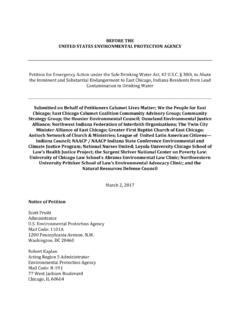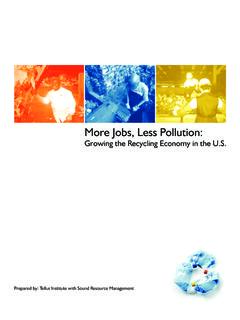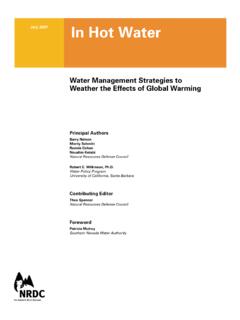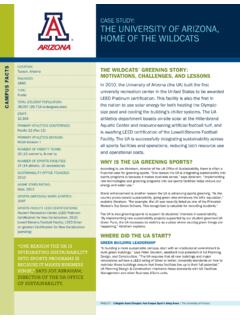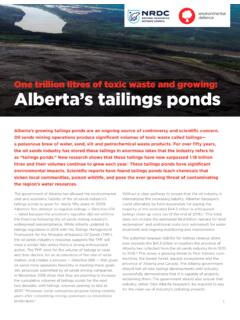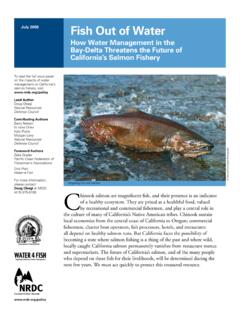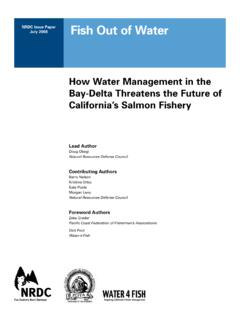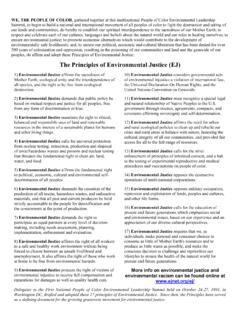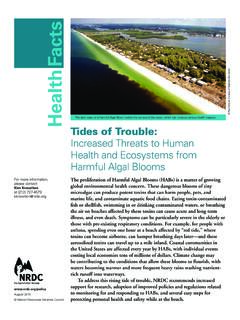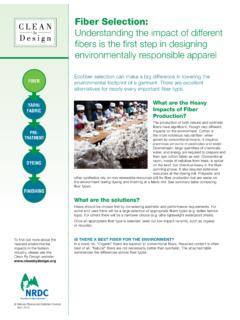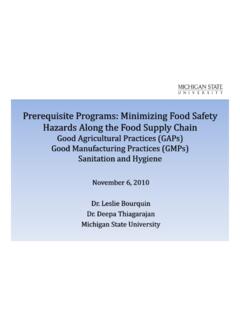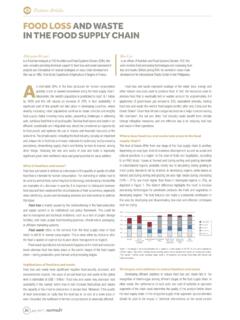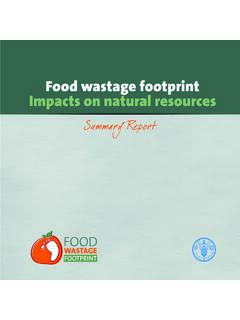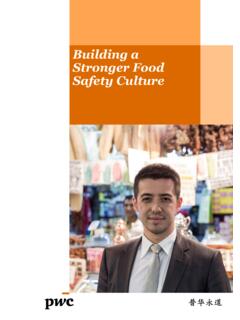Transcription of Wasted Food IP - Natural Resources Defense Council
1 AuthorDana Gunders Natural Resources Defense CouncilWasted: How America Is Losing Up to 40 Percent of Its food from Farm to Fork to Landfill Getting food from the farm to our fork eats up 10 percent of the total energy budget, uses 50 percent of land, and swallows 80 percent of all freshwater consumed in the United States. Yet, 40 percent of food in the United States today goes uneaten. This not only means that Americans are throwing out the equivalent of $165 billion each year, but also that the uneaten food ends up rotting in landfills as the single largest component of municipal solid waste where it accounts for a large portion of methane emissions. Reducing food losses by just 15 percent would be enough food to feed more than 25 million Americans every year at a time when one in six Americans lack a secure supply of food to their tables.
2 Increasing the efficiency of our food system is a triple-bottom-line solution that requires collaborative efforts by businesses, governments and consumers. The government should conduct a comprehensive study of losses in our food system and set national goals for waste reduction; businesses should seize opportunities to streamline their own operations, reduce food losses and save money; and consumers can waste less food by shopping wisely, knowing when food goes bad, buying produce that is perfectly edible even if it s less cosmetically attractive, cooking only the amount of food they need, and eating their PAPeRAUGUST 2012 IP:12-06-BAcknowledgmentsGreat thanks to the following people for reviewing the contents of this report: Jose Alvarez, Senior Lecturer, Harvard Business School and former CEO, Stop & Shop/Giant Landover Jonathan Bloom, Author of American WastelandBrian Lipinski, World Resources Institute Jean Schwab, EPA National food Recovery InitiativeAndrew Shakman, LeanPathReviewers do not necessarily concur with the paper s recommendations but have advised on portions of its content.
3 About NrDCThe Natural Resources Defense Council (NRDC) is an international nonprofit environmental organization with more than million members and online activists. Since 1970, our lawyers, scientists, and other environmental specialists have worked to protect the world's Natural Resources , public health, and the environment. NRDC has offices in New York City, Washington, , Los Angeles, San Francisco, Chicago, Livingston, Montana, and Beijing. Visit us at and follow us on Twitter s policy publications aim to inform and influence solutions to the world s most pressing environmental and public health issues. For additional policy content, visit our online policy portal at NRDC Director of Communications: Phil GutisNRDC Deputy Director of Communications: Lisa GoffrediNRDC Policy Publications Director: Alex KennaughLead Editor: Alex KennaughDesign and Production: photo Uli Westphal/ Natural Resources Defense Council 2012 PAGE 3 | Wasted : How America Is Losing Up to 40 Percent of Its food from Farm to Fork to LandfilltAblE of CoNtENtsExecutive summary.
4 4 Efficiency losses in the food supply system ..7 Losses in Farming ..7 Losses in Post-Harvest and in Packing ..8 Losses in Processing ..9 Losses in Distribution ..9 Losses in Retail ..10 Losses in food Service ..11 Losses in Household ..12 Losses during Disposal ..14toward More Efficiencies in the food system ..15 Businesses Should Help Remove Inefficiencies in the food System ..15 Government Should Help Remove Inefficiencies in the food System ..16 Consumers can Also Help Remove Inefficiencies in the food System ..17 Steps to Pursue at each Stage in the Supply chain ..18 Appendix: summary of food Waste by supply chain stage ..21 PAGE 4 | Wasted : How America Is Losing Up to 40 Percent of Its food from Farm to Fork to LandfillFood is simply too good to waste. Even the most sustainably farmed food does us no good if the food is never eaten.
5 Getting food to our tables eats up 10 percent of the total energy budget,1 uses 50 percent of land,2 and swallows 80 percent of freshwater consumed in the United Yet, 40 percent of food in the United States today goes That is more than 20 pounds of food per person every Not only does this mean that Americans are throwing out the equivalent of $165 billion each year,6 but also 25 percent of all freshwater7 and huge amounts of unnecessary chemicals, energy, and land. Moreover, almost all of that uneaten food ends up rotting in landfills where organic matter accounts for 16 percent of methane Nutrition is also lost in the mix food saved by reducing losses9 by just 15 percent could feed more than 25 million Americans every year10 at a time when one in six Americans lack a secure supply of food to their Given all the Resources demanded for food production, it is critical to make sure that the least amount possible is needlessly squandered on its journey to our paper examines the inefficiencies in the food system from the farm to the fork to the landfill.
6 By identifying food losses at every level of the food supply chain , this report provides the latest recommendations and examples of emerging solutions, such as making baby carrots out of carrots too bent (or curvy ) to meet retail standards. By increasing the efficiency of our food system, we can make better use of our Natural Resources , provide financial saving opportunities along the entire supply chain , and enhance our ability to meet food demand. The average American consumer wastes 10 times as much food as someone in Southeast Asia,12 up 50 percent from Americans in the This means there was once a time when we Wasted far less, and we can get back there again. Doing so will ultimately require a suite of coordinated solutions, including changes in supply- chain operation, enhanced market incentives, increased public awareness and adjustments in consumer suMMAryPAGE 5 | Wasted : How America Is Losing More Than 30 Percent of Its food from Farm to Fork to Landfill PAGE 5 | Wasted : How America Is Losing More Than 30 Percent of Its food from Farm to Fork to Landfill ** PRODUCTSSEAFOODFRUITS & VEGETABLESMEATMILK33%28%12%27%17%POSTHAR VEST,HANDLING ANDSTORAGE PRODUCTSSEAFOODFRUITS & VEGETABLESMEATMILK2%.
7 5%3%2%.25%PROCESSINGAND PRODUCTSSEAFOODFRUITS & VEGETABLESMEATMILK10%5%1%4%.5%DISTRUBUTI ONAND PRODUCTSSEAFOODFRUITS & VEGETABLESMEATMILK2% PRODUCTSSEAFOODFRUITS & VEGETABLESMEATMILK2%11%20%3%3% food CONSUMED VERSUS food LOSS*GRAIN PRODUCTSSEAFOODFRUITS AND VEGETABLESMEATMILK38% LOSS 50% LOSS 52% LOSS 22% LOSS 20% LOSS CONSUMED 62%CONSUMED 50%CONSUMED 48%CONSUMED 78%CONSUMED 80%**Includes out-of-home consumption*Percentages calculated collectively for USA, Canada, Australia, and New can be learned from work that is already under way in Europe. Both the United Kingdom and the European Union have conducted research to better understand the drivers of the problem and identify potential solutions. In January 2012, the European Parliament adopted a resolution to reduce food waste by 50 percent by 2020 and designated 2014 as the European year against food waste.
8 14 An extensive public awareness campaign called Love food Hate Waste has been conducted over the past five years and 53 of the leading food retailers and brands there have adopted a resolution to reduce waste in their own operations, as well as upstream and downstream in the supply chain . Gains can be made quickly. In just five years, avoidable household food waste in the United Kingdom has been reduced 18 The complexity of the issue cannot be ignored. At the heart are two basic realities that must be acknowledged upfront. The first is that food represents a small portion of many Americans budgets, making the financial cost of wasting food too low to outweigh the convenience of it. Second, there is the plain economic truth that the more food consumers waste, the more those in the food industry are able to sell.
9 This is true throughout the supply chain where waste downstream translates to higher sales for anyone upstream. Overcoming these challenges as well as the other drivers of food waste discussed in this document will require all hands on deck from the government to consumers to business. It will also require raising the priority of reducing food waste to the significant level it merits. The time to act is now. In fact, a recent report by consulting firm McKinsey ranks reducing food waste as one of the top three opportunities to improve resource Key prospects for change agents include: n The government should conduct a comprehensive study for food losses in our food system and establish national goals for food waste reduction. One key action will be to standardize and clarify the meaning of date labels on food so that consumers stop throwing out items due to misinterpretation.
10 A waste reduction organization in the United Kingdom has estimated this type of clarification could prevent about 20 percent of Wasted food in State and local governments should lead by setting targets and implementing food waste prevention campaigns in their jurisdictions as well as their own operations. One key opportunity for this is education alongside municipal composting Businesses should start by understanding the extent and opportunity of their own waste streams and adopting best practices. For example, Stop and Shop was able to save an estimated $100 million annually after an analysis of freshness, shrink, and customer satisfaction in their perishables Americans can help reduce waste by learning when food goes bad, buying imperfect produce, and storing and cooking food with an eye to reducing waste.
